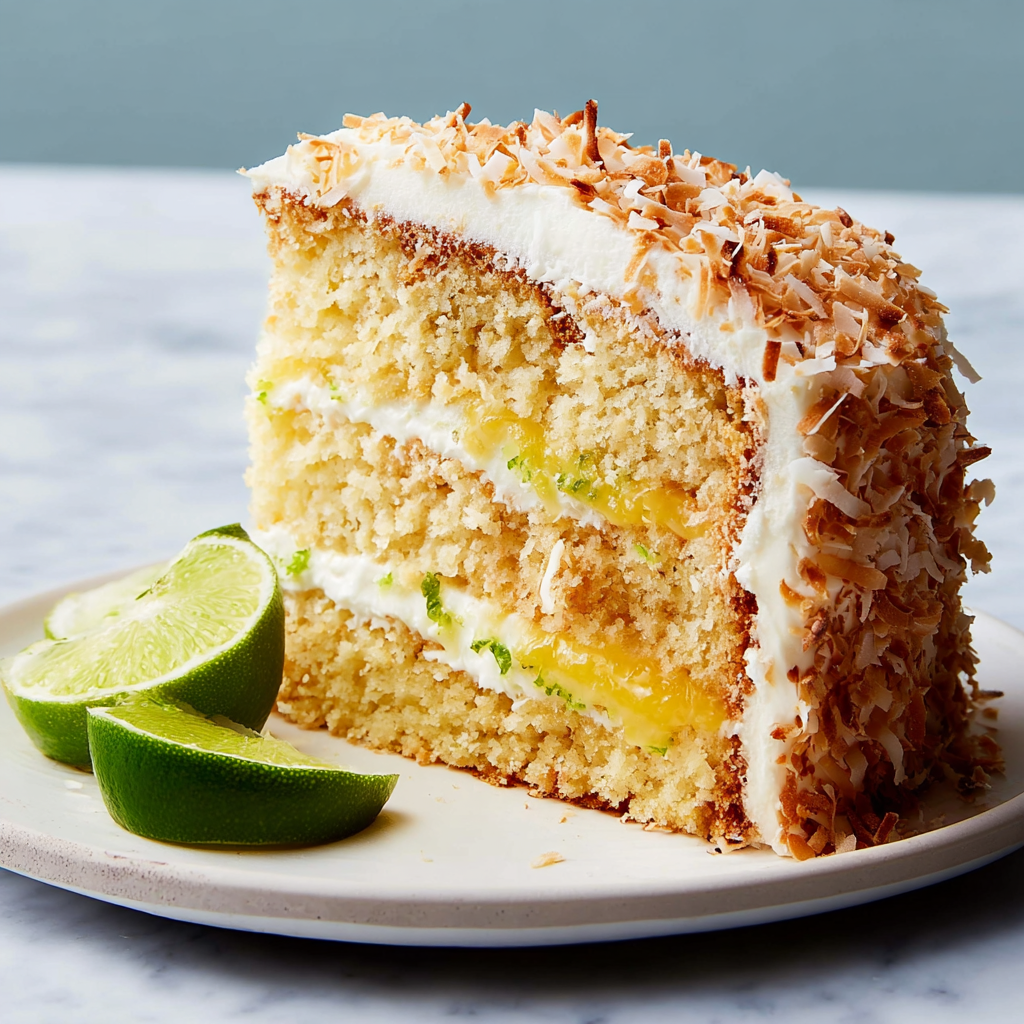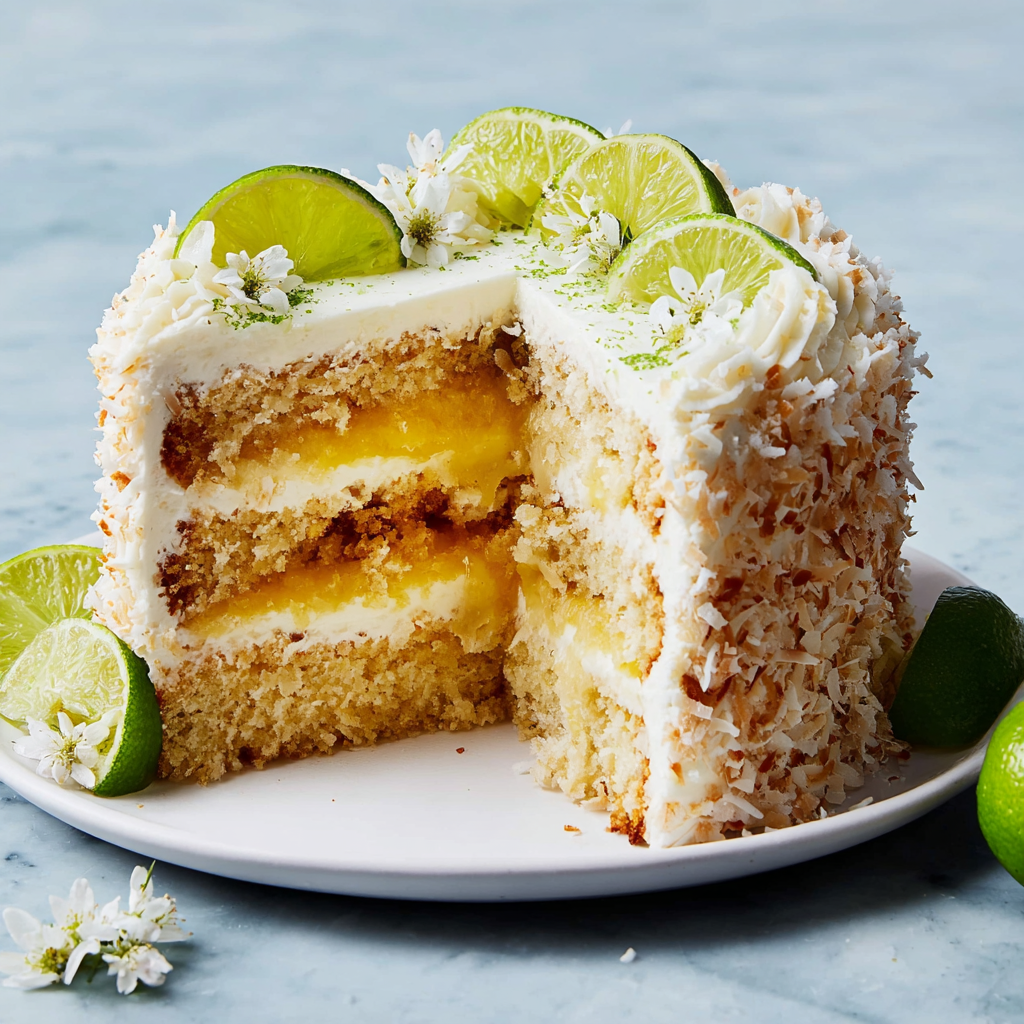 Save Pin
Save Pin
This coconut-lime layer cake is a show-stopping dessert that brings lush tropical flavors together with each bite. It’s a celebration cake full of tangy lime curd, toasted coconut, and the softest cake crumb thanks to both cream of coconut and buttermilk. I love how every part has its role without overwhelming you—each slice shows off sunny citrus and the rich, toasted crunch of coconut.
The first time I made this was for a summer potluck and everyone went back for seconds. My niece even asked for it at her birthday that same year. It’s now a requested favorite for any celebration in our family.
Ingredients
- All-purpose flour: for the right structure and tender crumb—choose unbleached for best texture
- Baking powder and baking soda: to give the cakes a balanced, high lift
- Kosher salt: enhances all flavors and balances sweetness—avoid regular table salt for subtlety
- Granulated sugar: brings sweetness and helps cream the butter for lightness
- Unsalted butter: at room temperature creates a rich crumb and silky frosting—use high-quality butter for best flavor
- Lime zest: brings floral, citrus notes to the cake, so choose limes that feel heavy for their size
- Vanilla extract: warms and deepens the flavor profile—pure extract is best
- Sweetened cream of coconut: gives the cake signature tropical richness—Coco Lopez or a similar brand works beautifully
- Eggs and egg yolks: for richness, structure, and that luscious lime curd—fresh, large eggs are key
- Buttermilk: ensures tender layers with a touch of tang—shake before measuring
- Fresh lime juice: for the curd—use juicy, glossy limes
- Powdered sugar: gives the frosting a whipped, smooth finish—sift for no lumps
- Cream cheese: in the frosting brings velvety tanginess
- Coconut extract: infuses extra coconut aroma—look for clear extract if you care about frosting color
- Sweetened coconut flakes: for toasting, adding crunch and a gorgeous finish
- Parchment paper: helps cakes release easily, keeping layers pristine
Step-by-Step Instructions
- Prepare the Cake Pans:
- Grease three eight-inch cake pans thoroughly. Line bottoms with parchment circles. Spray again so nothing sticks during baking.
- Mix Dry Ingredients:
- Whisk all-purpose flour with baking powder, kosher salt, and baking soda in a medium bowl. This ensures an even rise in the oven.
- Cream the Butter and Sugar:
- Beat granulated sugar, butter, lime zest, and vanilla with a mixer until very fluffy and light. This step traps air, giving the cake a soft, airy structure.
- Add Cream of Coconut and Eggs:
- Blend in sweetened cream of coconut until smooth and fully combined. Add eggs one by one, beating each time so the batter stays light.
- Incorporate Dry Mix and Buttermilk:
- Add half the flour mixture and just mix to combine. Pour in buttermilk and the rest of the dry mix, blending only until you see no streaks of flour. This keeps the crumb super tender.
- Divide and Bake:
- Evenly scoop batter into the prepared pans. Level tops gently. Bake in the center of a preheated 350 degree oven, rotating pans midway, for thirty five to forty five minutes or until a tester comes out clean.
- Cool the Cakes:
- Let cakes cool in pans on a rack for ten minutes then flip out gently and peel off parchment. Cool completely.
- Make the Lime Curd:
- Whisk egg yolks and sugar thoroughly in a saucepan. Add lime juice, salt, and butter. Cook and whisk constantly over medium heat until it thickens and coats the spoon but does not scramble. Strain if needed. Chill until thick and cool.
- Prepare the Frosting:
- Beat powdered sugar, butter, cream cheese, coconut extract, and kosher salt with a mixer until fluffy and pale. This takes about three minutes.
- Toast the Coconut Flakes:
- Spread coconut flakes on a sheet pan and bake at three fifty for about ten minutes, stirring halfway, until golden and toasty. Cool before using.
- Assemble the Cake:
- Trim cake layers flat with a serrated knife so they stack neatly. Place one layer on your serving plate, pipe a ring of frosting around the edge, and fill the center with half the lime curd. Repeat with the next layer, using the rest of the curd. Top with the final cake layer. Chill so the curd firms up.
- Finish with Frosting and Coconut:
- Generously frost the top and sides then press cooled coconut flakes into the frosting so they adhere all around.
- Decorate and Chill:
- Pipe decorative swirls of frosting on top and garnish each swirl with a lime wedge. Chill for about one hour so the cake slices easily.
 Save Pin
Save Pin
The toasted coconut is my personal favorite part—it reminds me of making coconut macaroons with my grandmother. She always let me sneak the warm, toasty bits off the baking tray first.
Storage Tips
Leftover cake can be stored in the refrigerator for up to four days. Press a piece of plastic wrap directly onto any cut sides to prevent drying. For best texture, let slices come to room temperature before serving. If you want to make the cake ahead, bake the layers and prepare the curd a day before, then assemble just before serving.
Ingredient Substitutions
If you cannot find cream of coconut, use full-fat coconut milk with a few tablespoons of extra sugar. To make the cake gluten-free, swap in your favorite 1 to 1 baking flour blend. If you don’t have coconut extract, a little extra vanilla will still give a delicious flavor. Lemon juice works instead of lime in a pinch, though the citrus punch will be milder.
 Save Pin
Save Pin
Serving Suggestions
This cake makes a beautiful centerpiece for birthdays or any tropical-themed gathering. For extra flair, sprinkle with candied lime zest or top with edible flowers. Serve each slice with sweetened whipped cream and fresh berries for color and freshness.
A Bit of History
Coconut and lime together is a classic pairing in tropical desserts across the world, from Southeast Asian bakes to classic American cakes. The use of both lime curd and coconut in several forms in this recipe draws on that tradition, creating layers of texture and taste that would make any island bakery proud.
Commonly Asked Questions
- → How do I prevent the lime curd from becoming lumpy?
Constant, gentle whisking over medium heat is essential to create a silky curd. If you see bits of scrambled egg, simply press the finished curd through a fine-mesh sieve for a smooth texture.
- → What can I do with leftover egg whites?
Leftover egg whites can be stored in an airtight container in the fridge. They’re perfect for making omelets, meringues, or even pavlova.
- → Can I substitute cream of coconut with coconut milk?
Cream of coconut is thicker and sweeter and gives a more pronounced coconut flavor and richness. Regular coconut milk will change the texture and taste; it’s best to use the cream version as listed.
- → How do I keep the cake moist?
Be sure not to overbake and let the cakes cool properly before assembly. The cream of coconut and buttermilk both add moisture to the cake for a tender crumb.
- → Why is buttermilk used in the batter?
Buttermilk brings a touch of tang and helps to tenderize the cake, resulting in a soft and balanced crumb.
- → What’s the best way to press coconut onto the cake?
After frosting, gently press the toasted coconut flakes onto the sides and top while the frosting is still soft to help them adhere.
